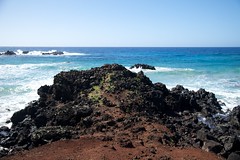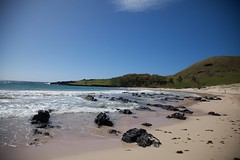 |
| Easter Island (Photo credit: Ndecam) |
Environmental Issues
various environmental issues
Observations:
Easter Island is remote and located in the Pacific Ocean. In 1722, the landscape was described as “barren” and was only populated by fewer than 20,000 people. The people of Easter Island lived in caves and had a few “meager” crops. Explorers also noted several hundred gigantic stone statues, indicating a sophisticated civilization had previously existed on the island.
Hypothesis:
The sophisticated inhabitants of Easter Island overused their limited number of natural resources, resulting in a more primitive form of survival to emerge.
Results:
 |
| Easter Island (Photo credit: Ndecam) |
After implementing the scientific method to the questions surrounding Easter Island, the logical conclusion would be that the hypothesis is correct. Taking into consideration the pictures on cave walls and the large statues that were meticulously erected in specific places, one can conclude that there once were numerous trees on the island. In addition to this evidence, soil tests were conducted which differentiated the types of trees once found on Easter Island. In the course of investigating the soil, 21 different plant species, predominantly trees, were identified to have once existed on Easter Island, but sadly are completely eliminated. Since the trees were eliminated, soil erosion caused a loss of productivity on the agricultural front, therefore resulting in less crop yields with increasing years. The erosion was able to be proven by looking at the lakes and the sediment that has accumulated at the bottom of them. As a result of the decrease in available food, population decline was inevitable and imminent. Scientists found that with the decrease in food and population, those that were left became very protective of the few resources they had and built fortresses with entry ways in order to protect their few crops and live animals from others. As the text states, this led to “clan warfare” amongst the few remaining people on Easter Island. Weapons were located in the soil as well as human remains that had head wounds on the skulls.
Summary:
 |
| Easter Island (Photo credit: Ndecam) |
What happened to the people of Easter Island is a warning for the rest of the world. Even though it was on a much smaller scale, the harsh lessons the people of this island learned can definitely be beneficial to today’s world population. While there are many people across the world who do not overuse limited resources, there are a significant amount of those who do. As Easter Island used up all of their primary resource, trees, the decline of civilization as they knew it fell quickly afterwards. As the modern world today is so dependent on the limited resource of oil, we too can find ourselves in a similar predicament in the not so far off future. The lessons learned in history can help teach us how to prevent such a catastrophe in our future, providing we utilize those lessons and teachings. Even though oil is the primary commodity in current societies, there are still other limited resources we depend on, such as trees (for building supplies, heat, etc.), fish (food source), and metals (for building materials, equipment, and transportation needs). All of these materials are used in such an exaggerated fashion that we may find ourselves without any resources in the very near future. One local example for me is the salmon located in the Pacific Northwest. If the salmon hatcheries were not protected and the fishing limited, the salmon would have already been extinct in our area.
types of environmental issues
Reference:





